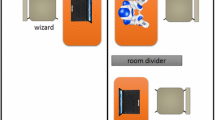Abstract
To successfully integrate into society, today’s robots, largely non-anthropomorphic, need to be able to communicate with people in various roles. In this paper, we focus on the military robot domain, where radio silence and high cognitive loads are par for the course, making nonverbal means of communication a necessity. To better understand how the findings in nonverbal communication using visual (lights) and auditory (non-speech sounds) channels from other domains could apply to the military, we conducted an exploratory survey soliciting opinions from laymen and experts on communicative abilities of a small non-anthropomorphic ground robot. For this study, we used Clearpath Jackal, equipped with a string of LED lights and a speaker to produce nonverbal cues in three different vignettes, and obtained feedback from 16 participants. Our study revealed a number of important issues in nonverbal signal design: importance of context and individual differences, challenge of ambiguity of meaning, and disambiguation of multiple simultaneous messages.
Access this chapter
Tax calculation will be finalised at checkout
Purchases are for personal use only
Similar content being viewed by others
References
Moshkina, L., Saucer, T., Spinola, M., Crossman, J.: Variable fidelity simulation and replay for unmanned autonomous ground vehicles. To appear in Proc. SAE World Congress Experience (2019)
US Department of Defense. Unmanned Systems Integrated Roadmap FY2011-2036. LULU COM (2015)
Minsun, K., Lee, J., Lee, H., Kim, S., Jung, H., Han, K.: The color and blink frequency of LED notification lights and smartphone users’ urgency perception. In: International Conference on Human-Computer Interaction, pp. 621–625 (2014)
Lenert, L., Palmer, D., Chan, T., Rao, R.: An intelligent 802.11 triage tag for medical response to disasters. In: AMIA Annual Symposium Proceedings, vol. 2005, p. 440. American Medical Informatics Association (2005)
Tarasewich, P., Campbell, C., Xia, T., Dideles, M.: Evaluation of visual notification cues for ubiquitous computing. In: International Conference on Ubiquitous Computing, pp. 349–366. Springer (2003)
Löcken, A., Heuten, W., Boll, S.: Enlightening drivers: A survey on in-vehicle light displays. In: AutomotiveUI 2016 - 8th International Conference on Automotive User Interfaces and Interactive Vehicular Applications, Proceedings, pp. 97–104 (2016)
Baraka, K., Paiva, A., Veloso, M.: Expressive lights for revealing mobile service robot state. In: Robot 2015: Second Iberian Robotics Conference, pp. 107–119. Springer, Cham (2016)
Cha, E., Matarić, M.: Using nonverbal signals to request help during human-robot collaboration. In: Intelligent Robots and Systems (IROS), 2016 IEEE/RSJ International Conference on, pp. 5070–5076. IEEE (2016)
Cha, E., Kim, Y., Fong, T., Mataric, M.J.: A survey of nonverbal signaling methods for non-humanoid robots. Found. Trends Robot. 6(4), 211–323 (2018)
Szafir, D., Mutlu, B., Fong, T.: Communicating directionality in flying robots. In: Proceedings of the Tenth Annual ACM/IEEE International Conference on Human-Robot Interaction, pp. 19–26. ACM (2015)
Szafir, D., Mutlu, B., Fong, T.: Communication of intent in assistive free flyers. In: Proceedings of the 2014 ACM/IEEE International Conference on Human-Robot Interaction, pp. 358–365. ACM (2014)
Takayama, L., Dooley, D., Ju, W.: Expressing thought: improving robot readability with animation principles. In: Human-Robot Interaction (HRI), 2011 6th ACM/IEEE International Conference on, pp. 69–76. IEEE (2011)
Author information
Authors and Affiliations
Corresponding author
Editor information
Editors and Affiliations
Rights and permissions
Copyright information
© 2020 Springer Nature Switzerland AG
About this paper
Cite this paper
Boos, L., Moshkina, L. (2020). Conveying Robot State and Intent Nonverbally in Military-Relevant Situations: An Exploratory Survey. In: Chen, J. (eds) Advances in Human Factors in Robots and Unmanned Systems. AHFE 2019. Advances in Intelligent Systems and Computing, vol 962. Springer, Cham. https://doi.org/10.1007/978-3-030-20467-9_17
Download citation
DOI: https://doi.org/10.1007/978-3-030-20467-9_17
Published:
Publisher Name: Springer, Cham
Print ISBN: 978-3-030-20466-2
Online ISBN: 978-3-030-20467-9
eBook Packages: Intelligent Technologies and RoboticsIntelligent Technologies and Robotics (R0)




